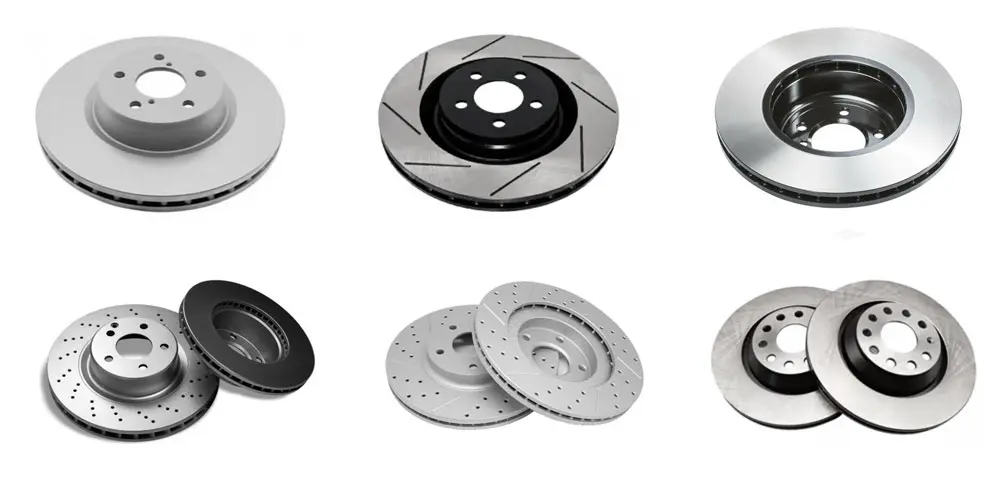Brake rotors are crucial components of your vehicle’s braking system, and they come in various designs: smooth (or plain), drilled, and slotted. While they all perform the fundamental task of slowing your vehicle, their unique designs offer different advantages and disadvantages. Understanding the difference between drilled, slotted, and smooth rotors is key to choosing the right braking solution for your driving needs and vehicle type.
The Core Function of Brake Rotors
Essentially, brake rotors are the metal discs that rotate with your wheels. When you press the brake pedal, your brake pads clamp down on these rotors, creating friction that converts kinetic energy into heat, ultimately slowing your car. Therefore, a rotor’s primary responsibilities are to provide a consistent friction surface and efficiently dissipate heat.
1. Smooth (Plain) Rotors: The Standard
What They Are: Smooth rotors, also known as plain or blank rotors, are the most common type found on the vast majority of production vehicles. As their name suggests, they have a completely flat, unblemished surface where the brake pads make contact.
Pros:
- Cost-Effective: Undeniably, they are the least expensive to manufacture and replace.
- Maximum Surface Area: Since they are smooth, they offer the largest continuous surface area for the brake pads to grip, which is excellent for heat absorption and consistent braking under normal conditions.
- Durability: They are structurally the strongest because they have no holes or slots that could create stress points. Consequently, they are less prone to cracking.
- Quiet Operation: Generally, smooth rotors are the quietest option, producing minimal noise.
Cons:
- Limited Heat Dissipation: However, under heavy or prolonged braking, they are less efficient at dissipating heat compared to drilled or slotted options, making them more susceptible to brake fade.
- Gas/Debris Trapping: Gases and brake dust can become trapped between the pad and rotor, potentially reducing friction.
2. Slotted Rotors: Performance & Debris Management
What They Are: Slotted rotors feature grooves or channels machined into their friction surface. These slots can be straight, curved, or angled.
Pros:
- Improved “Bite” & Consistency: The slots act like wipers, scraping away brake dust, gases, and water from the pad surface. As a result, this keeps the contact area clean, leading to better initial bite and more consistent braking, especially in wet conditions.
- Heat Management: While not as much as drilled, the slots do aid in heat dissipation by allowing hot gases to escape. This helps combat brake fade.
- Pad Glazing Prevention: The slots help to “shave” off glazed material from the brake pads, exposing fresh friction material and extending pad effectiveness.
- Structural Integrity: Comparatively, they retain more structural integrity than drilled rotors, making them a popular choice for performance street use and even some track applications.
Cons:
- Increased Pad Wear: The wiping action of the slots can sometimes lead to slightly faster brake pad wear.
- Noise: Occasionally, slotted rotors can produce a subtle “hum” or “rumble” noise due to the air passing through the slots.
- Higher Cost: Naturally, they are more expensive than smooth rotors due to the additional machining process.
3. Drilled Rotors: Aesthetics & Wet Performance
What They Are: Drilled rotors have a series of holes drilled completely through the rotor’s friction surface.
Pros:
- Enhanced Wet Performance: The holes provide an escape route for water, significantly improving initial brake bite in rainy conditions.
- Improved Heat Dissipation (Initial): The increased surface area created by the holes helps dissipate heat, particularly useful in less extreme braking scenarios.
- Aesthetics: Visually, drilled rotors offer a sporty, high-performance look, which is a primary reason many drivers choose them.
- Gas Venting (Historically): Originally, the holes were crucial for venting gases produced by older, organic brake pad compounds. This benefit is less pronounced with modern pad materials.
Cons:
- Prone to Cracking: Crucially, the drilled holes create stress points, making these rotors more susceptible to cracking, especially under repeated heavy braking or extreme heat (e.g., track use).
- Reduced Surface Area: The holes reduce the overall contact surface area between the pad and rotor, which can slightly diminish maximum braking force.
- Increased Cost: Similar to slotted, they are more expensive due to machining.
Combination (Drilled & Slotted) Rotors
Furthermore, many aftermarket rotors combine both drilled holes and slots, aiming to harness the benefits of both designs. However, these still share the drawbacks, such as potential cracking issues under extreme stress, although modern manufacturing techniques aim to mitigate these risks.
Choosing the Right Rotor for You
The best rotor type depends on your driving habits:
- Daily Driving: For most commuters, smooth rotors are perfectly adequate and cost-effective.
- Performance Street Driving / Occasional Spirited Driving: For these conditions, slotted rotors offer enhanced performance and cleanliness without compromising too much structural integrity. Drilled rotors can also work well, especially if aesthetics and wet performance are a priority, but be mindful of the cracking risk under very hard use.
- Track Use / Heavy Duty / Towing: In these demanding scenarios, performance-oriented slotted rotors or even solid, high-carbon rotors designed for extreme heat are generally preferred due to their superior structural integrity and heat management. Drilled rotors are often avoided for dedicated track use due to cracking potential.
In conclusion, while all rotors stop your car, their design impacts performance, durability, and aesthetics. Therefore, consider your driving style and needs before making your choice, and always consult with a trusted mechanic for expert advice.




